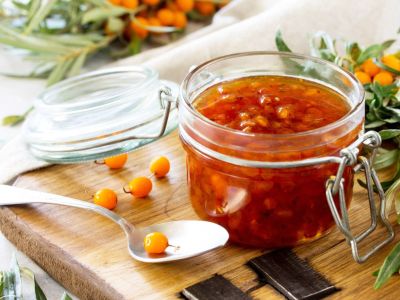Sea buckthorn fruit harvesting is dangerous to the skin. This is because the hardy, stoic plants are covered in vicious thorns. But after some careful extraction, the fruit may be used several ways. The name translates to ” Dune Thorn” and the plant is also known as Sand Thorn and Siberian pineapple. The plants, with their rangy root systems, are often used for soil stability. In marginal areas, they help keep soil held on slopes.
The Sea Buckthorn Plant
Sea buckthorn is deciduous and grows as either a shrub or small tree. Plants grow up to 19 feet (6 m.) in height. They are rangy branched, roughly spiked, and overall very hardy plants. Adapted to cold, brisk windy areas, the plants tend to lean a bit. In the wild they occupy coastal regions in dunes and moors. The gloriously orange berries are ripe from September to October. The plant is dioecious which means it requires both a male and female plant to produce flowers and set fruit. As an added bonus, sea buckthorn plants can fix nitrogen, improving soil and nearby plant health. In the U.S. and Canada, the plant has been successfully introduced as habitat on poor, dry soil sites. Those wicked thorns are flanked by very attractive, narrow, oval, silver leaves.
Sea Buckthorn Uses
Historically, the plant is said to have medicinal properties, and indeed, today supplements made from the berries are available. The young leaves are made into tea, useful for its antioxidant properties, as well as amino and fatty acid, and mineral levels. Leaves are also used to make an oil that is high in tannin. The fruit is high in Vitamins C, E, and A. It is made into cosmetic treatments and topical medical ointments. Due to the high fatty acid levels, the fruit is being trialed as a preventative for some cancers. Sea buckthorn fruit is common eaten raw or cooked, as a juice, or in preserves. Sea buckthorn juice is said to be quite tart, but the addition of sweetener can improve the flavor.
How to Make Sea Buckthorn Preserves
Start by harvesting the berries. The best flavor will come from fruit that is deeply orange, which are the ripest. They will be sticky, and soft. Wash the fruit thoroughly and remove any twigs or leaves that may have gotten into the batch. The berries will be cooked in half as much water as weight of berries. In other words, they are just covered with water in the pot. Simmer for 20 minutes on medium low. Then strain out the solids. What is left is pure sea buckthorn juice. Next, sweeten the juice. The amount of sugar depends upon how sweet you want the taste. Boil vigorously for around 10 minutes, stirring frequently. Skim off the foam and check the set. If necessary, boil for a few more minutes. Then can the jelly as usual.
